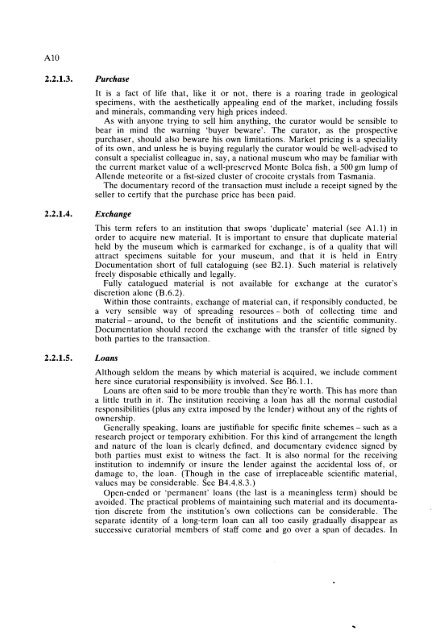GUIDELINES FOR THE CURATION OF GEOLOGICAL MATERIALS
GUIDELINES FOR THE CURATION OF GEOLOGICAL MATERIALS
GUIDELINES FOR THE CURATION OF GEOLOGICAL MATERIALS
You also want an ePaper? Increase the reach of your titles
YUMPU automatically turns print PDFs into web optimized ePapers that Google loves.
2.2.1.3. Purchase<br />
2.2.1.4. Exchange<br />
2.2.1.5. Loans<br />
It is a fact of life that, like it or not, there is a roaring trade in geological<br />
specimens, with the aesthetically appealing end of the market, including fossils<br />
and minerals, commanding very high prices indeed.<br />
As with anyone trying to sell him anything, the curator would be sensible to<br />
bear in mind the warning 'buyer beware'. The curator, as the prospective<br />
purchaser, should also beware his own limitations. Market pricing is a speciality<br />
of its own, and unless he is buying regularly the curator would be well-advised to<br />
consult a specialist colleague in, say, a national museum who may be familiar with<br />
the current market value of a well-preserved Monte Bolca fish, a 500 gm lump of<br />
Allende meteorite or a fist-sized cluster of crocoite crystals from Tasmania.<br />
The documentary record of the transaction must include a receipt signed by the<br />
seller to certify that the purchase price has been paid.<br />
This term refers to an institution that swops 'duplicate' material (see Al.l) in<br />
order to acquire new material. It is important to ensure that duplicate material<br />
held by the museum which is earmarked for exchange, is of a quality that will<br />
attract specimens suitable for your museum, and that it is held in Entry<br />
Documentation short of full cataloguing (see B2.1). Such material is relatively<br />
freely disposable ethically and legally.<br />
Fully catalogued material is not available for exchange at the curator's<br />
discretion alone (B.6.2).<br />
Within those contraints, exchange of material can, if responsibly conducted, be<br />
a very sensible way of spreading resources- both of collecting time and<br />
material - around, to the benefit of institutions and the scientific community.<br />
Documentation should record the excha~lge with the transfer of title signed by<br />
both parties to the transaction.<br />
Although seldom the means by which material is acquired, we include comment<br />
here since curatorial responsibility is involved. See B6.1.1.<br />
Loans are often said to be more trouble than they're worth. This has more than<br />
a little truth in it. The institution receiving a loan has all the normal custodial<br />
responsibilities (plus any extra imposed by the lender) without any of the rights of<br />
ownership.<br />
Generally speaking, loans are justifiable for specific finite schemes - such as a<br />
research project or temporary exhibition. For this kind of arrangement the length<br />
and nature of the loan is clearly defined, and documentary evidence signed by<br />
both parties must exist to witness the fact. It is also normal for the receiving<br />
institution to indemnify or insure the lender against the accidental loss of, or<br />
damage to, the loan. (Though in the case of irreplaceable scientific material,<br />
values may be considerable. See B4.4.8.3.)<br />
Open-ended or 'permanent' loans (the last is a meaningless term) should be<br />
avoided. The practical problems of maintaining such material and its documentation<br />
discrete from the institution's own collections can be considerable. The<br />
separate identity of a long-term loan can all too easily gradually disappear as<br />
successive curatorial members of staff come and go over a span of decades. In

















